Analysis of Environmental Systems Pty Ltd v Peerless Holdings
VerifiedAdded on 2022/12/05
|13
|3080
|245
Report
AI Summary
This report provides a comprehensive analysis of the Environmental Systems Pty Ltd v Peerless Holdings Pty Ltd case, focusing on contract law principles, particularly exclusion clauses and consequential loss. The report begins with a literature review on exclusion of liability, defining the concept and exploring its various forms and limitations. It then delves into the specifics of the case, summarizing the facts, the court's decision, and the reasoning behind it. The analysis identifies the key legal issues, including the interpretation of "consequential loss" and the application of exclusion clauses. The report examines how relevant laws, such as the Trade Practices Act and the Fair Trading Act, were applied. Finally, it offers a critical evaluation of the court's decision, assessing whether the law was appropriately applied and providing insights into the implications of the ruling on contract law. The report also mentions the importance of clearly defining terms within a contract and the potential consequences of unclear clauses. This case highlights the significance of understanding the scope and application of exclusion clauses in contract law and their impact on liability.
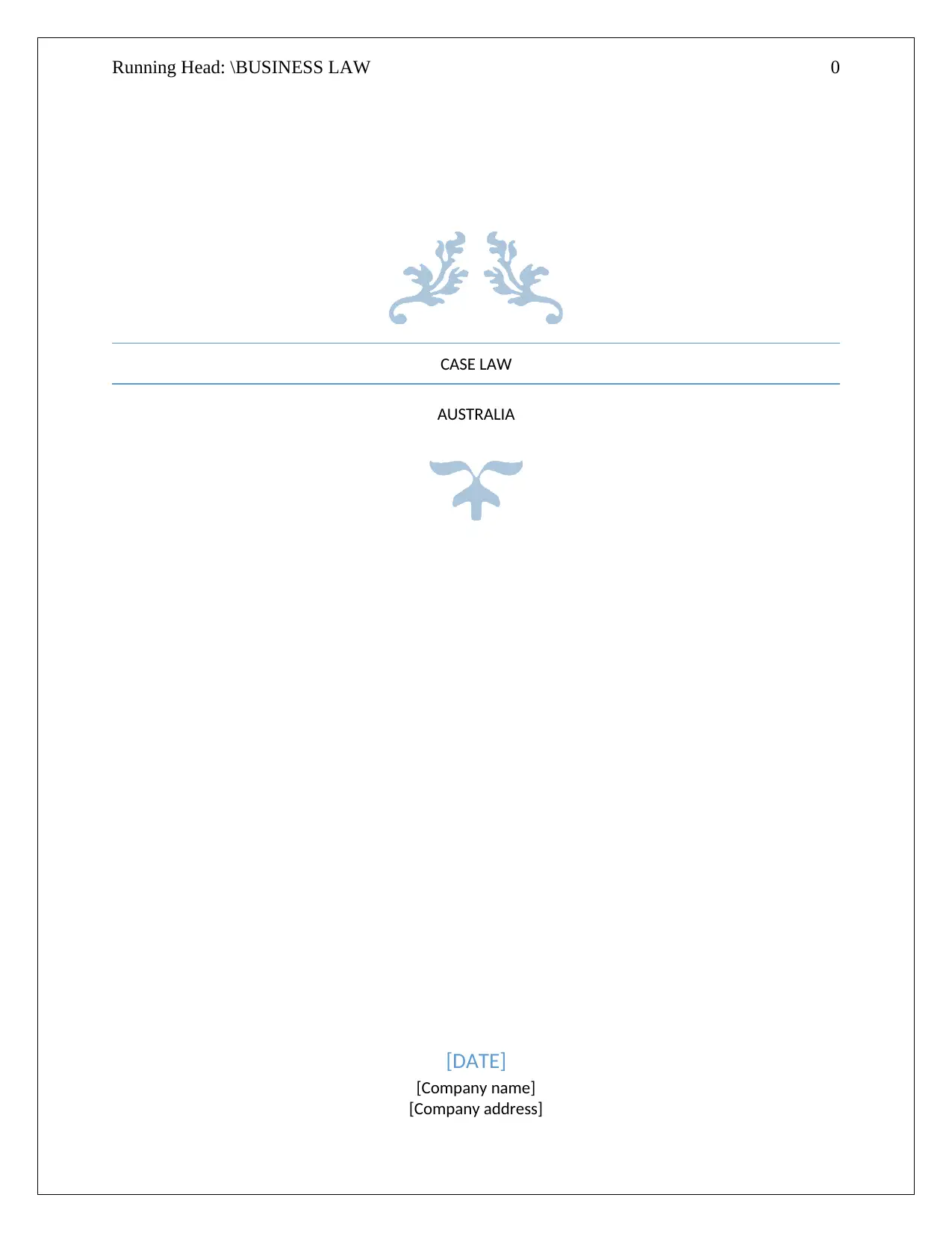
Running Head: \BUSINESS LAW 0
CASE LAW
AUSTRALIA
[DATE]
[Company name]
[Company address]
CASE LAW
AUSTRALIA
[DATE]
[Company name]
[Company address]
Paraphrase This Document
Need a fresh take? Get an instant paraphrase of this document with our AI Paraphraser
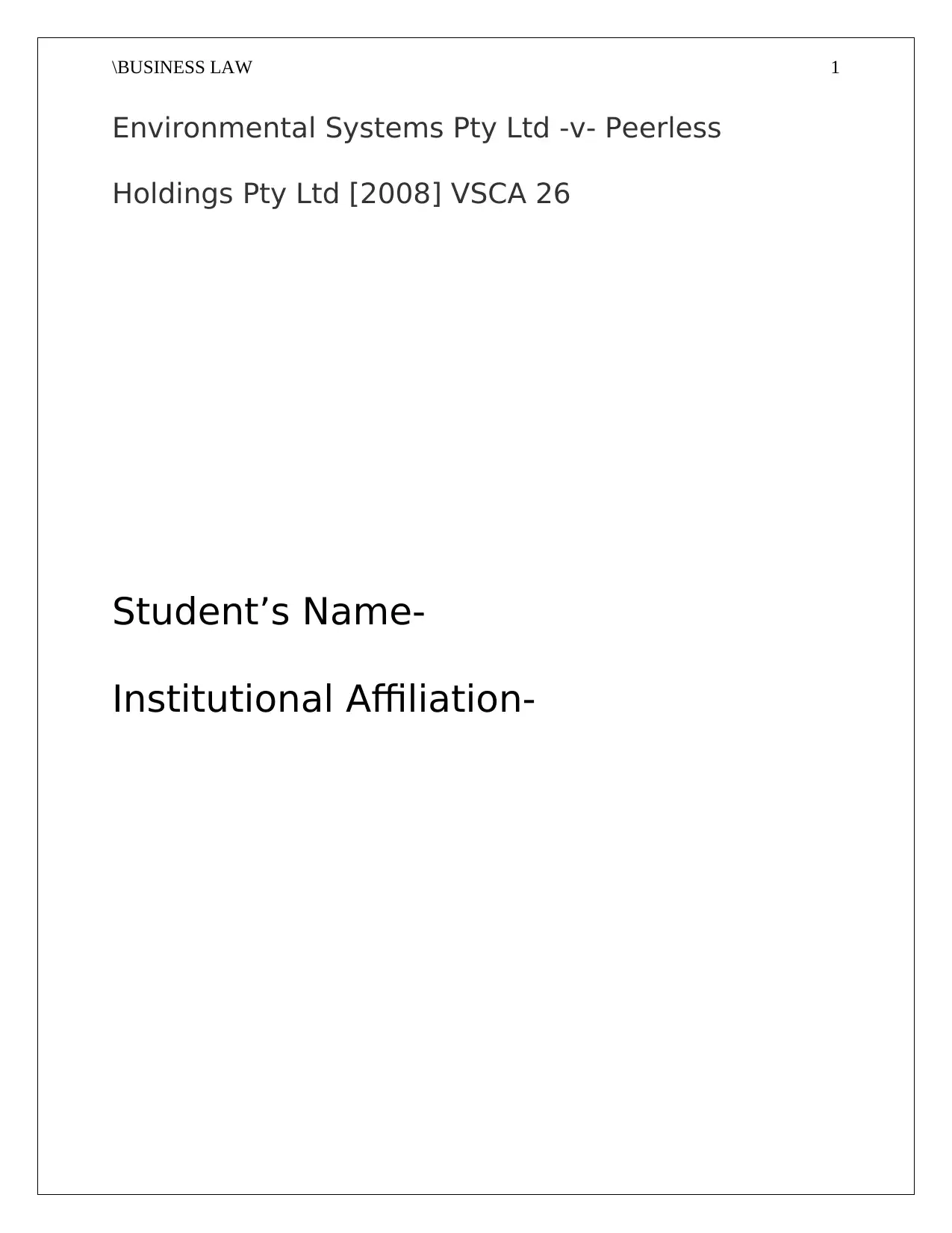
\BUSINESS LAW 1
Environmental Systems Pty Ltd -v- Peerless
Holdings Pty Ltd [2008] VSCA 26
Student’s Name-
Institutional Affiliation-
Environmental Systems Pty Ltd -v- Peerless
Holdings Pty Ltd [2008] VSCA 26
Student’s Name-
Institutional Affiliation-
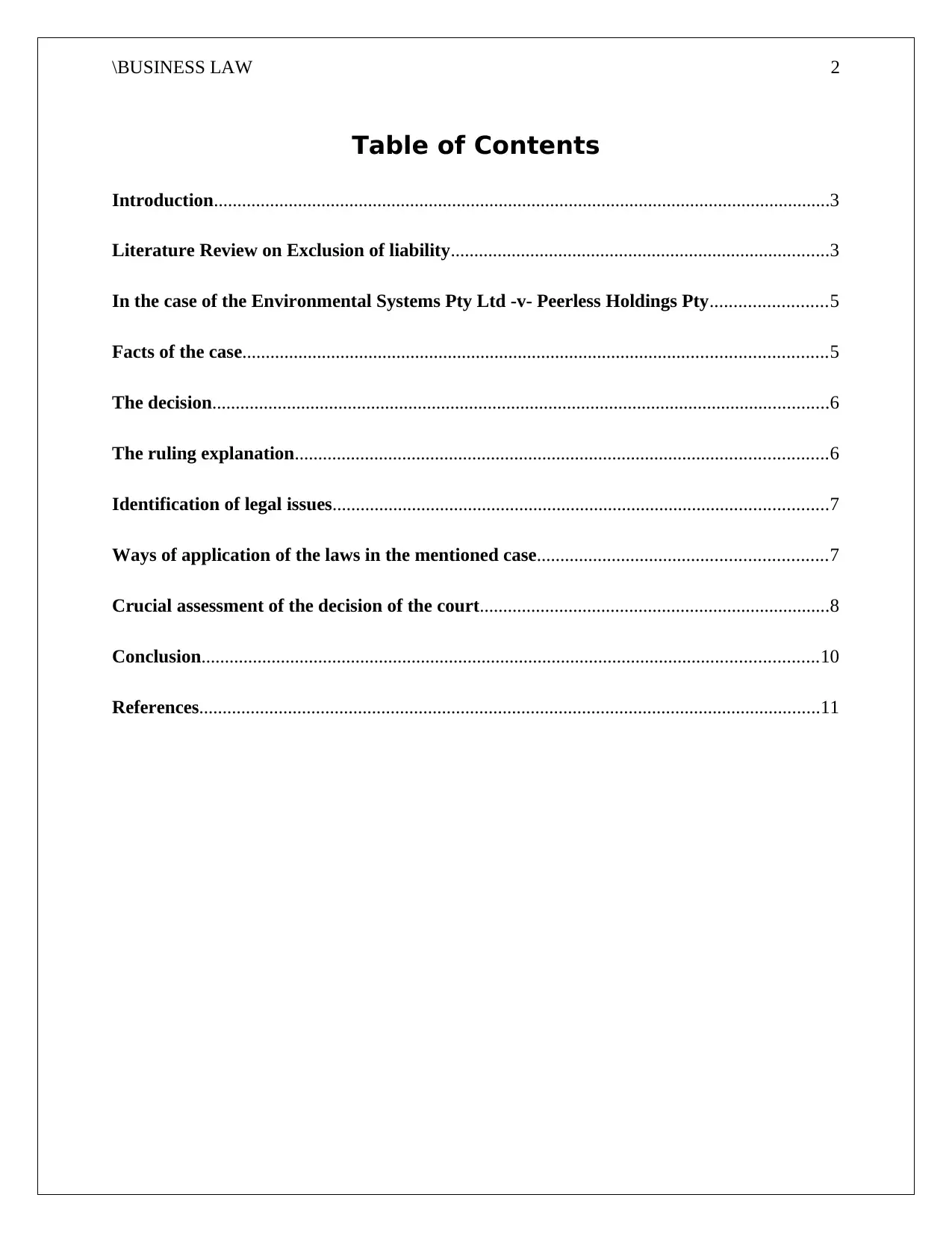
\BUSINESS LAW 2
Table of Contents
Introduction....................................................................................................................................3
Literature Review on Exclusion of liability.................................................................................3
In the case of the Environmental Systems Pty Ltd -v- Peerless Holdings Pty.........................5
Facts of the case.............................................................................................................................5
The decision....................................................................................................................................6
The ruling explanation..................................................................................................................6
Identification of legal issues..........................................................................................................7
Ways of application of the laws in the mentioned case..............................................................7
Crucial assessment of the decision of the court...........................................................................8
Conclusion....................................................................................................................................10
References.....................................................................................................................................11
Table of Contents
Introduction....................................................................................................................................3
Literature Review on Exclusion of liability.................................................................................3
In the case of the Environmental Systems Pty Ltd -v- Peerless Holdings Pty.........................5
Facts of the case.............................................................................................................................5
The decision....................................................................................................................................6
The ruling explanation..................................................................................................................6
Identification of legal issues..........................................................................................................7
Ways of application of the laws in the mentioned case..............................................................7
Crucial assessment of the decision of the court...........................................................................8
Conclusion....................................................................................................................................10
References.....................................................................................................................................11
⊘ This is a preview!⊘
Do you want full access?
Subscribe today to unlock all pages.

Trusted by 1+ million students worldwide
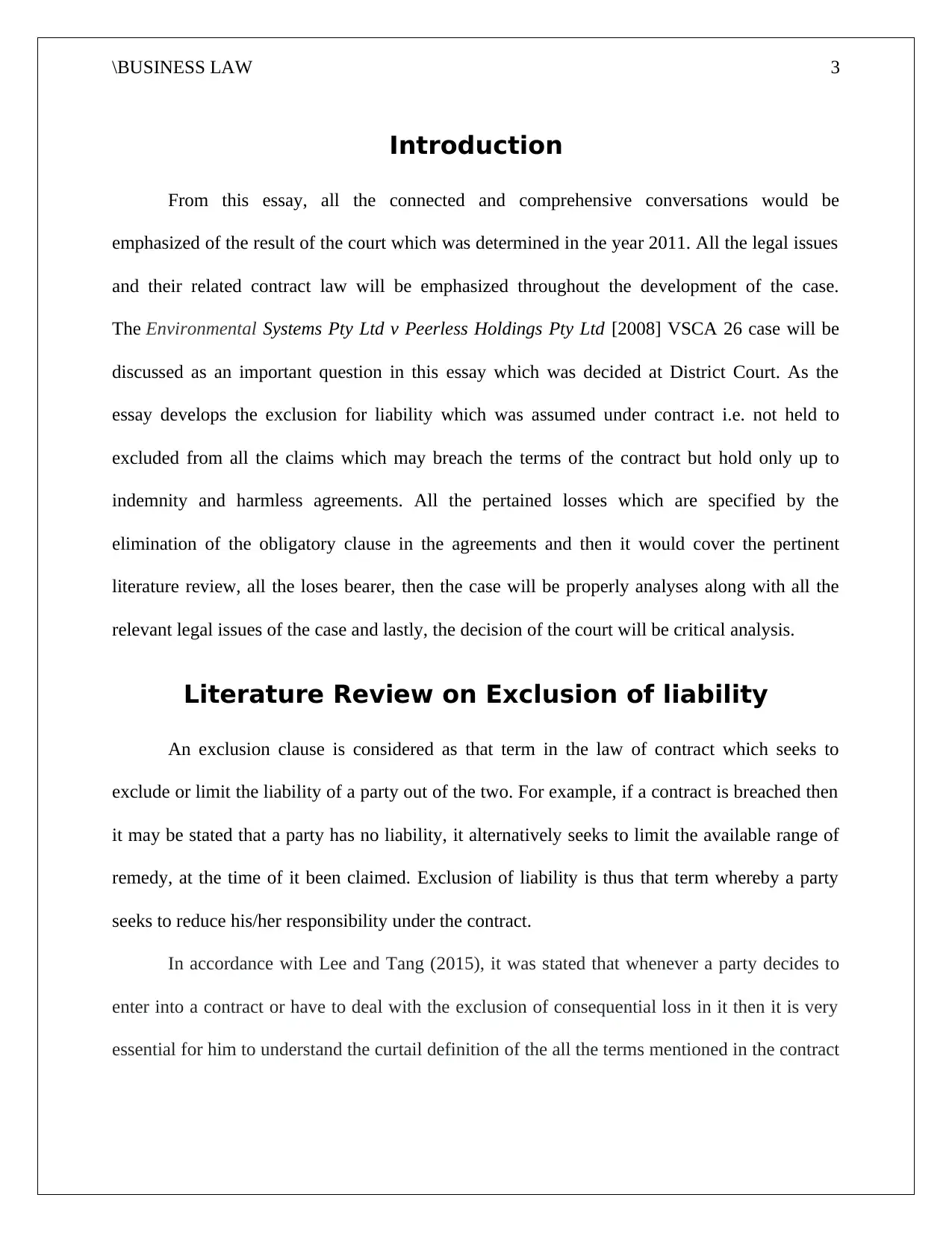
\BUSINESS LAW 3
Introduction
From this essay, all the connected and comprehensive conversations would be
emphasized of the result of the court which was determined in the year 2011. All the legal issues
and their related contract law will be emphasized throughout the development of the case.
The Environmental Systems Pty Ltd v Peerless Holdings Pty Ltd [2008] VSCA 26 case will be
discussed as an important question in this essay which was decided at District Court. As the
essay develops the exclusion for liability which was assumed under contract i.e. not held to
excluded from all the claims which may breach the terms of the contract but hold only up to
indemnity and harmless agreements. All the pertained losses which are specified by the
elimination of the obligatory clause in the agreements and then it would cover the pertinent
literature review, all the loses bearer, then the case will be properly analyses along with all the
relevant legal issues of the case and lastly, the decision of the court will be critical analysis.
Literature Review on Exclusion of liability
An exclusion clause is considered as that term in the law of contract which seeks to
exclude or limit the liability of a party out of the two. For example, if a contract is breached then
it may be stated that a party has no liability, it alternatively seeks to limit the available range of
remedy, at the time of it been claimed. Exclusion of liability is thus that term whereby a party
seeks to reduce his/her responsibility under the contract.
In accordance with Lee and Tang (2015), it was stated that whenever a party decides to
enter into a contract or have to deal with the exclusion of consequential loss in it then it is very
essential for him to understand the curtail definition of the all the terms mentioned in the contract
Introduction
From this essay, all the connected and comprehensive conversations would be
emphasized of the result of the court which was determined in the year 2011. All the legal issues
and their related contract law will be emphasized throughout the development of the case.
The Environmental Systems Pty Ltd v Peerless Holdings Pty Ltd [2008] VSCA 26 case will be
discussed as an important question in this essay which was decided at District Court. As the
essay develops the exclusion for liability which was assumed under contract i.e. not held to
excluded from all the claims which may breach the terms of the contract but hold only up to
indemnity and harmless agreements. All the pertained losses which are specified by the
elimination of the obligatory clause in the agreements and then it would cover the pertinent
literature review, all the loses bearer, then the case will be properly analyses along with all the
relevant legal issues of the case and lastly, the decision of the court will be critical analysis.
Literature Review on Exclusion of liability
An exclusion clause is considered as that term in the law of contract which seeks to
exclude or limit the liability of a party out of the two. For example, if a contract is breached then
it may be stated that a party has no liability, it alternatively seeks to limit the available range of
remedy, at the time of it been claimed. Exclusion of liability is thus that term whereby a party
seeks to reduce his/her responsibility under the contract.
In accordance with Lee and Tang (2015), it was stated that whenever a party decides to
enter into a contract or have to deal with the exclusion of consequential loss in it then it is very
essential for him to understand the curtail definition of the all the terms mentioned in the contract
Paraphrase This Document
Need a fresh take? Get an instant paraphrase of this document with our AI Paraphraser
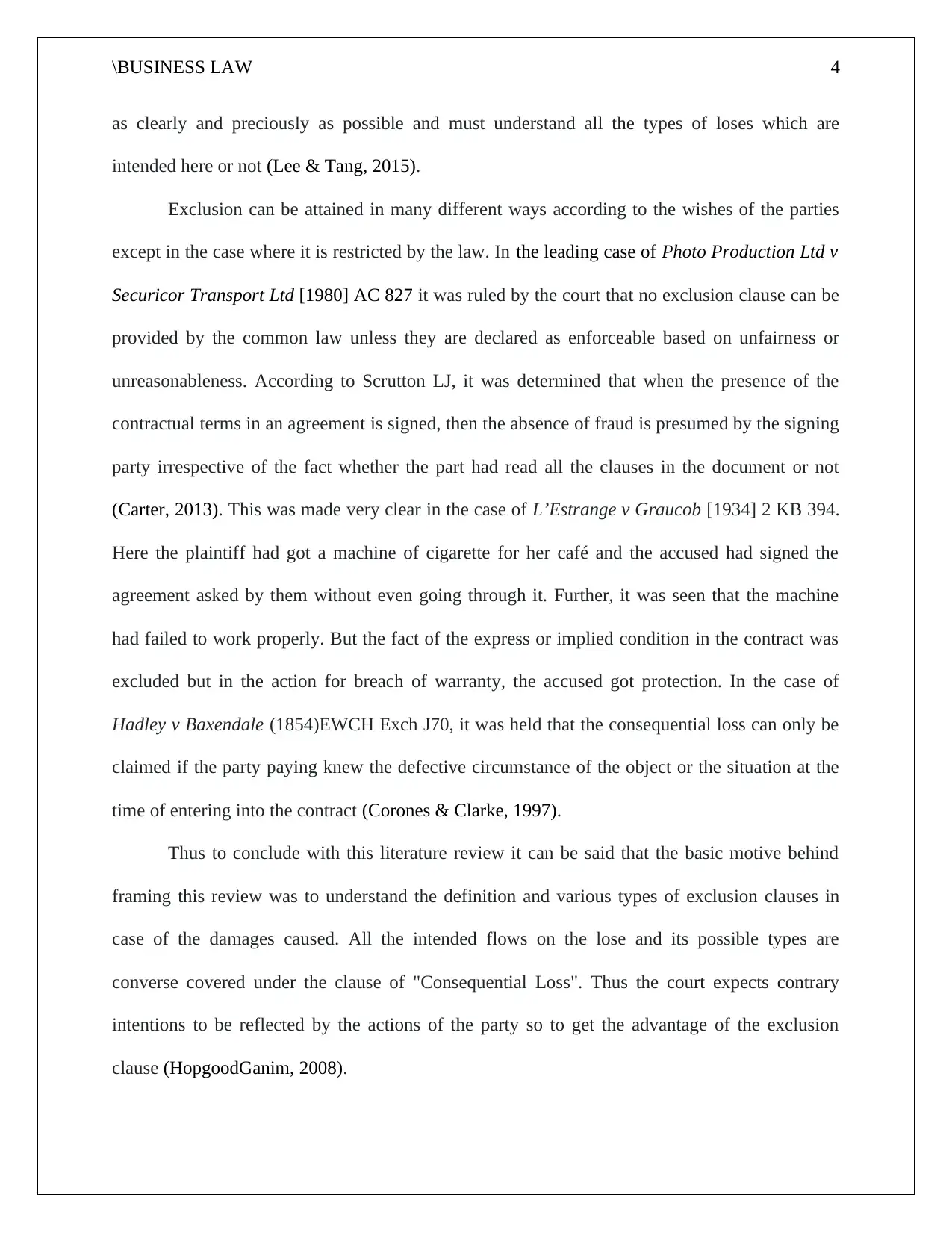
\BUSINESS LAW 4
as clearly and preciously as possible and must understand all the types of loses which are
intended here or not (Lee & Tang, 2015).
Exclusion can be attained in many different ways according to the wishes of the parties
except in the case where it is restricted by the law. In the leading case of Photo Production Ltd v
Securicor Transport Ltd [1980] AC 827 it was ruled by the court that no exclusion clause can be
provided by the common law unless they are declared as enforceable based on unfairness or
unreasonableness. According to Scrutton LJ, it was determined that when the presence of the
contractual terms in an agreement is signed, then the absence of fraud is presumed by the signing
party irrespective of the fact whether the part had read all the clauses in the document or not
(Carter, 2013). This was made very clear in the case of L’Estrange v Graucob [1934] 2 KB 394.
Here the plaintiff had got a machine of cigarette for her café and the accused had signed the
agreement asked by them without even going through it. Further, it was seen that the machine
had failed to work properly. But the fact of the express or implied condition in the contract was
excluded but in the action for breach of warranty, the accused got protection. In the case of
Hadley v Baxendale (1854)EWCH Exch J70, it was held that the consequential loss can only be
claimed if the party paying knew the defective circumstance of the object or the situation at the
time of entering into the contract (Corones & Clarke, 1997).
Thus to conclude with this literature review it can be said that the basic motive behind
framing this review was to understand the definition and various types of exclusion clauses in
case of the damages caused. All the intended flows on the lose and its possible types are
converse covered under the clause of "Consequential Loss". Thus the court expects contrary
intentions to be reflected by the actions of the party so to get the advantage of the exclusion
clause (HopgoodGanim, 2008).
as clearly and preciously as possible and must understand all the types of loses which are
intended here or not (Lee & Tang, 2015).
Exclusion can be attained in many different ways according to the wishes of the parties
except in the case where it is restricted by the law. In the leading case of Photo Production Ltd v
Securicor Transport Ltd [1980] AC 827 it was ruled by the court that no exclusion clause can be
provided by the common law unless they are declared as enforceable based on unfairness or
unreasonableness. According to Scrutton LJ, it was determined that when the presence of the
contractual terms in an agreement is signed, then the absence of fraud is presumed by the signing
party irrespective of the fact whether the part had read all the clauses in the document or not
(Carter, 2013). This was made very clear in the case of L’Estrange v Graucob [1934] 2 KB 394.
Here the plaintiff had got a machine of cigarette for her café and the accused had signed the
agreement asked by them without even going through it. Further, it was seen that the machine
had failed to work properly. But the fact of the express or implied condition in the contract was
excluded but in the action for breach of warranty, the accused got protection. In the case of
Hadley v Baxendale (1854)EWCH Exch J70, it was held that the consequential loss can only be
claimed if the party paying knew the defective circumstance of the object or the situation at the
time of entering into the contract (Corones & Clarke, 1997).
Thus to conclude with this literature review it can be said that the basic motive behind
framing this review was to understand the definition and various types of exclusion clauses in
case of the damages caused. All the intended flows on the lose and its possible types are
converse covered under the clause of "Consequential Loss". Thus the court expects contrary
intentions to be reflected by the actions of the party so to get the advantage of the exclusion
clause (HopgoodGanim, 2008).
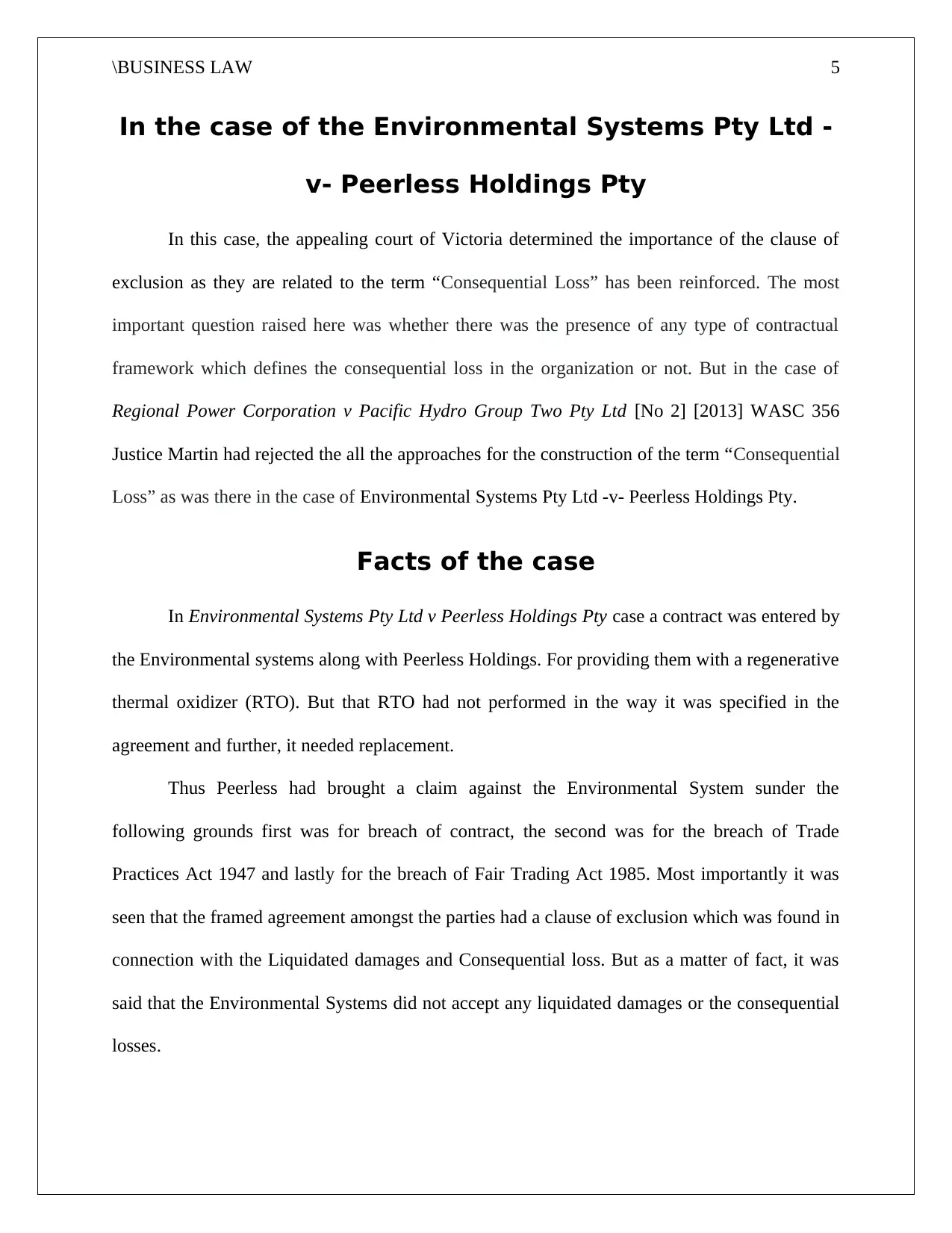
\BUSINESS LAW 5
In the case of the Environmental Systems Pty Ltd -
v- Peerless Holdings Pty
In this case, the appealing court of Victoria determined the importance of the clause of
exclusion as they are related to the term “Consequential Loss” has been reinforced. The most
important question raised here was whether there was the presence of any type of contractual
framework which defines the consequential loss in the organization or not. But in the case of
Regional Power Corporation v Pacific Hydro Group Two Pty Ltd [No 2] [2013] WASC 356
Justice Martin had rejected the all the approaches for the construction of the term “Consequential
Loss” as was there in the case of Environmental Systems Pty Ltd -v- Peerless Holdings Pty.
Facts of the case
In Environmental Systems Pty Ltd v Peerless Holdings Pty case a contract was entered by
the Environmental systems along with Peerless Holdings. For providing them with a regenerative
thermal oxidizer (RTO). But that RTO had not performed in the way it was specified in the
agreement and further, it needed replacement.
Thus Peerless had brought a claim against the Environmental System sunder the
following grounds first was for breach of contract, the second was for the breach of Trade
Practices Act 1947 and lastly for the breach of Fair Trading Act 1985. Most importantly it was
seen that the framed agreement amongst the parties had a clause of exclusion which was found in
connection with the Liquidated damages and Consequential loss. But as a matter of fact, it was
said that the Environmental Systems did not accept any liquidated damages or the consequential
losses.
In the case of the Environmental Systems Pty Ltd -
v- Peerless Holdings Pty
In this case, the appealing court of Victoria determined the importance of the clause of
exclusion as they are related to the term “Consequential Loss” has been reinforced. The most
important question raised here was whether there was the presence of any type of contractual
framework which defines the consequential loss in the organization or not. But in the case of
Regional Power Corporation v Pacific Hydro Group Two Pty Ltd [No 2] [2013] WASC 356
Justice Martin had rejected the all the approaches for the construction of the term “Consequential
Loss” as was there in the case of Environmental Systems Pty Ltd -v- Peerless Holdings Pty.
Facts of the case
In Environmental Systems Pty Ltd v Peerless Holdings Pty case a contract was entered by
the Environmental systems along with Peerless Holdings. For providing them with a regenerative
thermal oxidizer (RTO). But that RTO had not performed in the way it was specified in the
agreement and further, it needed replacement.
Thus Peerless had brought a claim against the Environmental System sunder the
following grounds first was for breach of contract, the second was for the breach of Trade
Practices Act 1947 and lastly for the breach of Fair Trading Act 1985. Most importantly it was
seen that the framed agreement amongst the parties had a clause of exclusion which was found in
connection with the Liquidated damages and Consequential loss. But as a matter of fact, it was
said that the Environmental Systems did not accept any liquidated damages or the consequential
losses.
⊘ This is a preview!⊘
Do you want full access?
Subscribe today to unlock all pages.

Trusted by 1+ million students worldwide
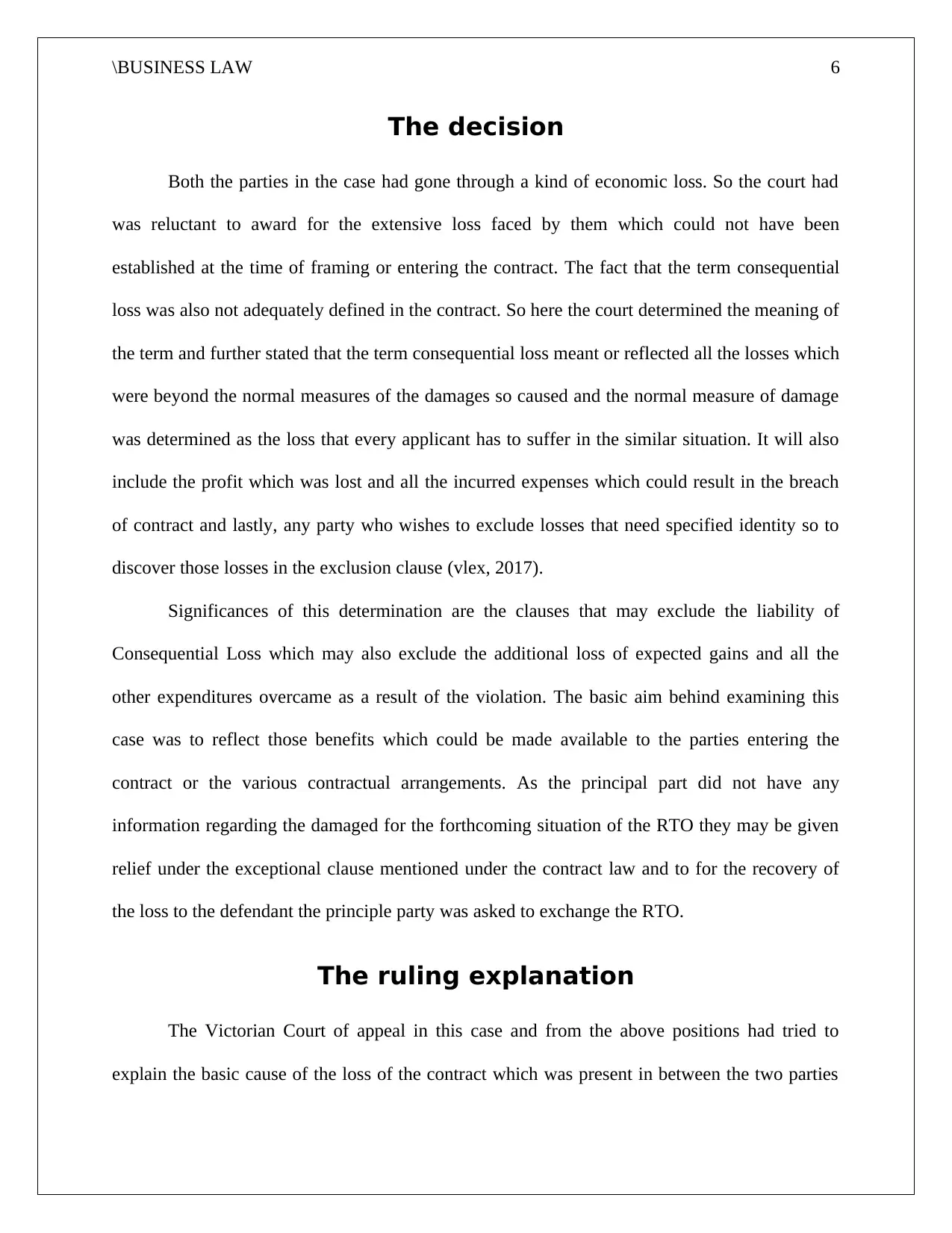
\BUSINESS LAW 6
The decision
Both the parties in the case had gone through a kind of economic loss. So the court had
was reluctant to award for the extensive loss faced by them which could not have been
established at the time of framing or entering the contract. The fact that the term consequential
loss was also not adequately defined in the contract. So here the court determined the meaning of
the term and further stated that the term consequential loss meant or reflected all the losses which
were beyond the normal measures of the damages so caused and the normal measure of damage
was determined as the loss that every applicant has to suffer in the similar situation. It will also
include the profit which was lost and all the incurred expenses which could result in the breach
of contract and lastly, any party who wishes to exclude losses that need specified identity so to
discover those losses in the exclusion clause (vlex, 2017).
Significances of this determination are the clauses that may exclude the liability of
Consequential Loss which may also exclude the additional loss of expected gains and all the
other expenditures overcame as a result of the violation. The basic aim behind examining this
case was to reflect those benefits which could be made available to the parties entering the
contract or the various contractual arrangements. As the principal part did not have any
information regarding the damaged for the forthcoming situation of the RTO they may be given
relief under the exceptional clause mentioned under the contract law and to for the recovery of
the loss to the defendant the principle party was asked to exchange the RTO.
The ruling explanation
The Victorian Court of appeal in this case and from the above positions had tried to
explain the basic cause of the loss of the contract which was present in between the two parties
The decision
Both the parties in the case had gone through a kind of economic loss. So the court had
was reluctant to award for the extensive loss faced by them which could not have been
established at the time of framing or entering the contract. The fact that the term consequential
loss was also not adequately defined in the contract. So here the court determined the meaning of
the term and further stated that the term consequential loss meant or reflected all the losses which
were beyond the normal measures of the damages so caused and the normal measure of damage
was determined as the loss that every applicant has to suffer in the similar situation. It will also
include the profit which was lost and all the incurred expenses which could result in the breach
of contract and lastly, any party who wishes to exclude losses that need specified identity so to
discover those losses in the exclusion clause (vlex, 2017).
Significances of this determination are the clauses that may exclude the liability of
Consequential Loss which may also exclude the additional loss of expected gains and all the
other expenditures overcame as a result of the violation. The basic aim behind examining this
case was to reflect those benefits which could be made available to the parties entering the
contract or the various contractual arrangements. As the principal part did not have any
information regarding the damaged for the forthcoming situation of the RTO they may be given
relief under the exceptional clause mentioned under the contract law and to for the recovery of
the loss to the defendant the principle party was asked to exchange the RTO.
The ruling explanation
The Victorian Court of appeal in this case and from the above positions had tried to
explain the basic cause of the loss of the contract which was present in between the two parties
Paraphrase This Document
Need a fresh take? Get an instant paraphrase of this document with our AI Paraphraser
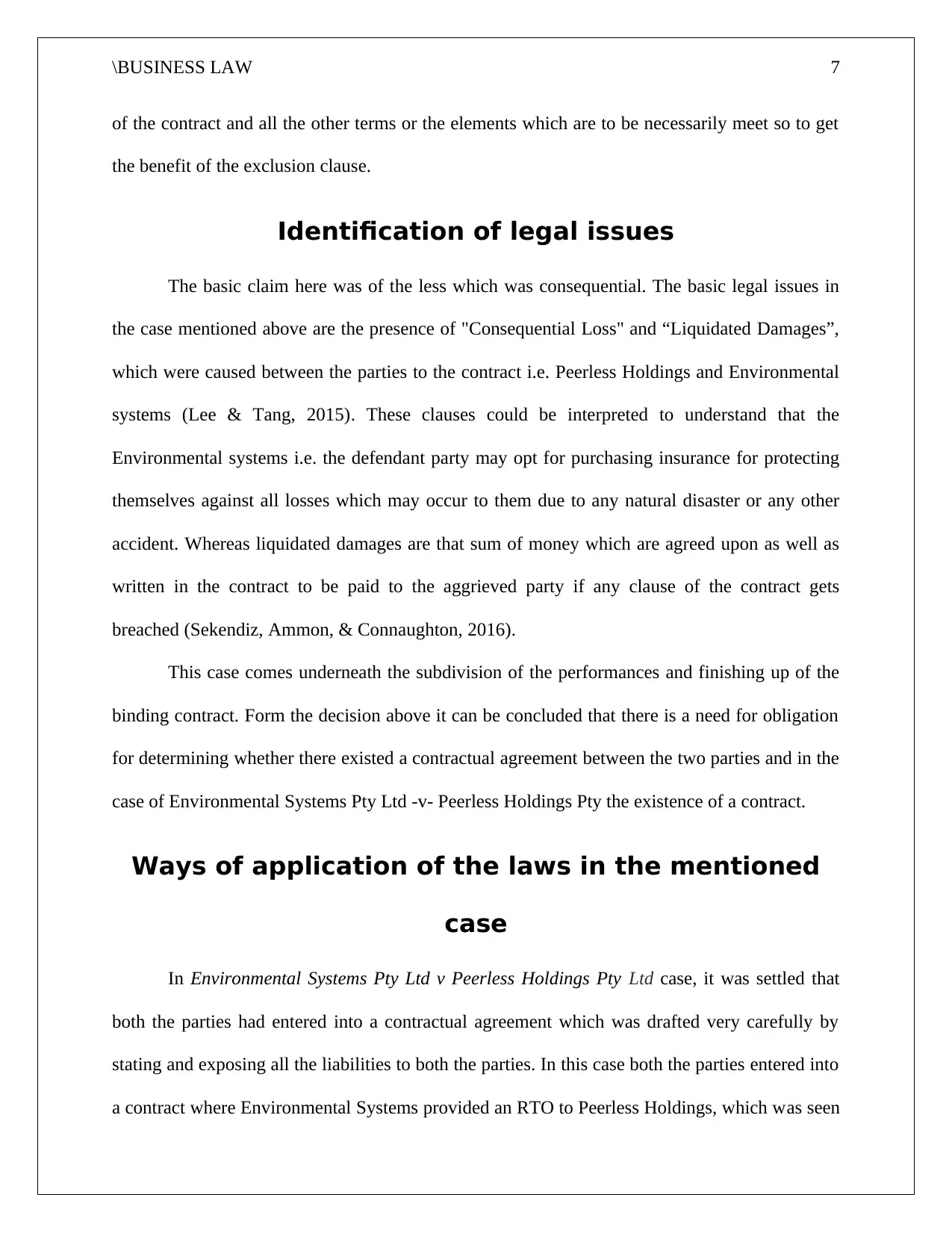
\BUSINESS LAW 7
of the contract and all the other terms or the elements which are to be necessarily meet so to get
the benefit of the exclusion clause.
Identification of legal issues
The basic claim here was of the less which was consequential. The basic legal issues in
the case mentioned above are the presence of "Consequential Loss" and “Liquidated Damages”,
which were caused between the parties to the contract i.e. Peerless Holdings and Environmental
systems (Lee & Tang, 2015). These clauses could be interpreted to understand that the
Environmental systems i.e. the defendant party may opt for purchasing insurance for protecting
themselves against all losses which may occur to them due to any natural disaster or any other
accident. Whereas liquidated damages are that sum of money which are agreed upon as well as
written in the contract to be paid to the aggrieved party if any clause of the contract gets
breached (Sekendiz, Ammon, & Connaughton, 2016).
This case comes underneath the subdivision of the performances and finishing up of the
binding contract. Form the decision above it can be concluded that there is a need for obligation
for determining whether there existed a contractual agreement between the two parties and in the
case of Environmental Systems Pty Ltd -v- Peerless Holdings Pty the existence of a contract.
Ways of application of the laws in the mentioned
case
In Environmental Systems Pty Ltd v Peerless Holdings Pty Ltd case, it was settled that
both the parties had entered into a contractual agreement which was drafted very carefully by
stating and exposing all the liabilities to both the parties. In this case both the parties entered into
a contract where Environmental Systems provided an RTO to Peerless Holdings, which was seen
of the contract and all the other terms or the elements which are to be necessarily meet so to get
the benefit of the exclusion clause.
Identification of legal issues
The basic claim here was of the less which was consequential. The basic legal issues in
the case mentioned above are the presence of "Consequential Loss" and “Liquidated Damages”,
which were caused between the parties to the contract i.e. Peerless Holdings and Environmental
systems (Lee & Tang, 2015). These clauses could be interpreted to understand that the
Environmental systems i.e. the defendant party may opt for purchasing insurance for protecting
themselves against all losses which may occur to them due to any natural disaster or any other
accident. Whereas liquidated damages are that sum of money which are agreed upon as well as
written in the contract to be paid to the aggrieved party if any clause of the contract gets
breached (Sekendiz, Ammon, & Connaughton, 2016).
This case comes underneath the subdivision of the performances and finishing up of the
binding contract. Form the decision above it can be concluded that there is a need for obligation
for determining whether there existed a contractual agreement between the two parties and in the
case of Environmental Systems Pty Ltd -v- Peerless Holdings Pty the existence of a contract.
Ways of application of the laws in the mentioned
case
In Environmental Systems Pty Ltd v Peerless Holdings Pty Ltd case, it was settled that
both the parties had entered into a contractual agreement which was drafted very carefully by
stating and exposing all the liabilities to both the parties. In this case both the parties entered into
a contract where Environmental Systems provided an RTO to Peerless Holdings, which was seen
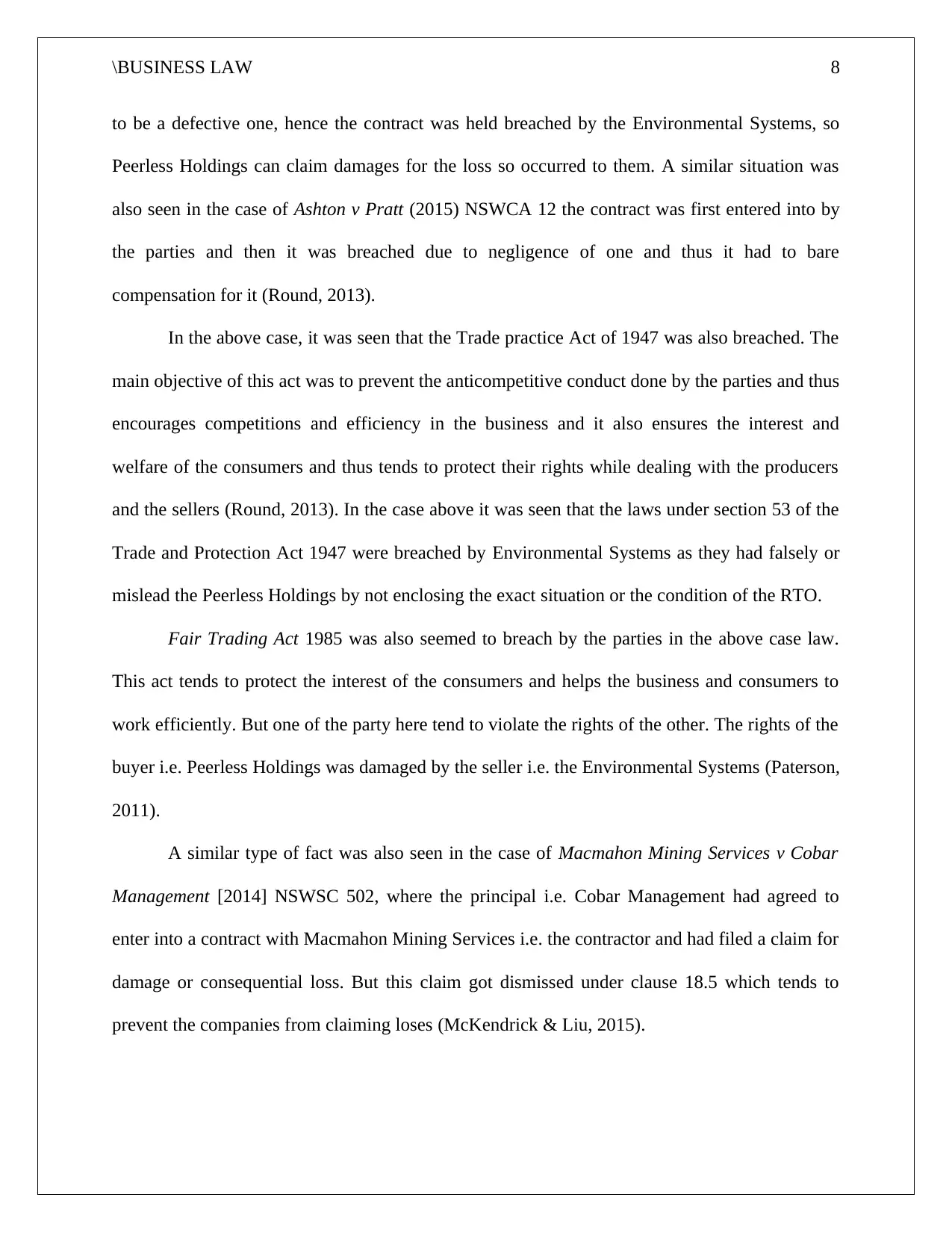
\BUSINESS LAW 8
to be a defective one, hence the contract was held breached by the Environmental Systems, so
Peerless Holdings can claim damages for the loss so occurred to them. A similar situation was
also seen in the case of Ashton v Pratt (2015) NSWCA 12 the contract was first entered into by
the parties and then it was breached due to negligence of one and thus it had to bare
compensation for it (Round, 2013).
In the above case, it was seen that the Trade practice Act of 1947 was also breached. The
main objective of this act was to prevent the anticompetitive conduct done by the parties and thus
encourages competitions and efficiency in the business and it also ensures the interest and
welfare of the consumers and thus tends to protect their rights while dealing with the producers
and the sellers (Round, 2013). In the case above it was seen that the laws under section 53 of the
Trade and Protection Act 1947 were breached by Environmental Systems as they had falsely or
mislead the Peerless Holdings by not enclosing the exact situation or the condition of the RTO.
Fair Trading Act 1985 was also seemed to breach by the parties in the above case law.
This act tends to protect the interest of the consumers and helps the business and consumers to
work efficiently. But one of the party here tend to violate the rights of the other. The rights of the
buyer i.e. Peerless Holdings was damaged by the seller i.e. the Environmental Systems (Paterson,
2011).
A similar type of fact was also seen in the case of Macmahon Mining Services v Cobar
Management [2014] NSWSC 502, where the principal i.e. Cobar Management had agreed to
enter into a contract with Macmahon Mining Services i.e. the contractor and had filed a claim for
damage or consequential loss. But this claim got dismissed under clause 18.5 which tends to
prevent the companies from claiming loses (McKendrick & Liu, 2015).
to be a defective one, hence the contract was held breached by the Environmental Systems, so
Peerless Holdings can claim damages for the loss so occurred to them. A similar situation was
also seen in the case of Ashton v Pratt (2015) NSWCA 12 the contract was first entered into by
the parties and then it was breached due to negligence of one and thus it had to bare
compensation for it (Round, 2013).
In the above case, it was seen that the Trade practice Act of 1947 was also breached. The
main objective of this act was to prevent the anticompetitive conduct done by the parties and thus
encourages competitions and efficiency in the business and it also ensures the interest and
welfare of the consumers and thus tends to protect their rights while dealing with the producers
and the sellers (Round, 2013). In the case above it was seen that the laws under section 53 of the
Trade and Protection Act 1947 were breached by Environmental Systems as they had falsely or
mislead the Peerless Holdings by not enclosing the exact situation or the condition of the RTO.
Fair Trading Act 1985 was also seemed to breach by the parties in the above case law.
This act tends to protect the interest of the consumers and helps the business and consumers to
work efficiently. But one of the party here tend to violate the rights of the other. The rights of the
buyer i.e. Peerless Holdings was damaged by the seller i.e. the Environmental Systems (Paterson,
2011).
A similar type of fact was also seen in the case of Macmahon Mining Services v Cobar
Management [2014] NSWSC 502, where the principal i.e. Cobar Management had agreed to
enter into a contract with Macmahon Mining Services i.e. the contractor and had filed a claim for
damage or consequential loss. But this claim got dismissed under clause 18.5 which tends to
prevent the companies from claiming loses (McKendrick & Liu, 2015).
⊘ This is a preview!⊘
Do you want full access?
Subscribe today to unlock all pages.

Trusted by 1+ million students worldwide
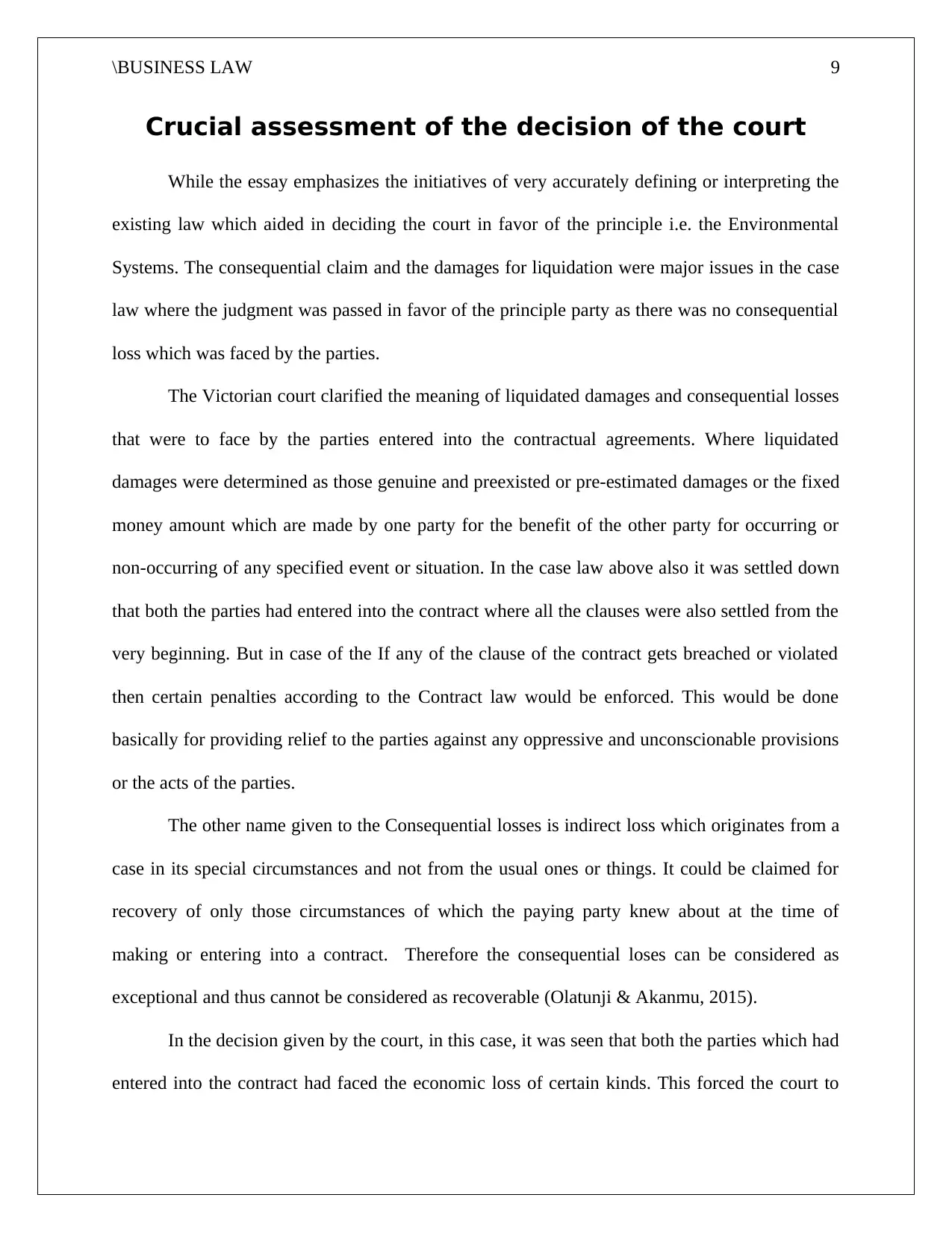
\BUSINESS LAW 9
Crucial assessment of the decision of the court
While the essay emphasizes the initiatives of very accurately defining or interpreting the
existing law which aided in deciding the court in favor of the principle i.e. the Environmental
Systems. The consequential claim and the damages for liquidation were major issues in the case
law where the judgment was passed in favor of the principle party as there was no consequential
loss which was faced by the parties.
The Victorian court clarified the meaning of liquidated damages and consequential losses
that were to face by the parties entered into the contractual agreements. Where liquidated
damages were determined as those genuine and preexisted or pre-estimated damages or the fixed
money amount which are made by one party for the benefit of the other party for occurring or
non-occurring of any specified event or situation. In the case law above also it was settled down
that both the parties had entered into the contract where all the clauses were also settled from the
very beginning. But in case of the If any of the clause of the contract gets breached or violated
then certain penalties according to the Contract law would be enforced. This would be done
basically for providing relief to the parties against any oppressive and unconscionable provisions
or the acts of the parties.
The other name given to the Consequential losses is indirect loss which originates from a
case in its special circumstances and not from the usual ones or things. It could be claimed for
recovery of only those circumstances of which the paying party knew about at the time of
making or entering into a contract. Therefore the consequential loses can be considered as
exceptional and thus cannot be considered as recoverable (Olatunji & Akanmu, 2015).
In the decision given by the court, in this case, it was seen that both the parties which had
entered into the contract had faced the economic loss of certain kinds. This forced the court to
Crucial assessment of the decision of the court
While the essay emphasizes the initiatives of very accurately defining or interpreting the
existing law which aided in deciding the court in favor of the principle i.e. the Environmental
Systems. The consequential claim and the damages for liquidation were major issues in the case
law where the judgment was passed in favor of the principle party as there was no consequential
loss which was faced by the parties.
The Victorian court clarified the meaning of liquidated damages and consequential losses
that were to face by the parties entered into the contractual agreements. Where liquidated
damages were determined as those genuine and preexisted or pre-estimated damages or the fixed
money amount which are made by one party for the benefit of the other party for occurring or
non-occurring of any specified event or situation. In the case law above also it was settled down
that both the parties had entered into the contract where all the clauses were also settled from the
very beginning. But in case of the If any of the clause of the contract gets breached or violated
then certain penalties according to the Contract law would be enforced. This would be done
basically for providing relief to the parties against any oppressive and unconscionable provisions
or the acts of the parties.
The other name given to the Consequential losses is indirect loss which originates from a
case in its special circumstances and not from the usual ones or things. It could be claimed for
recovery of only those circumstances of which the paying party knew about at the time of
making or entering into a contract. Therefore the consequential loses can be considered as
exceptional and thus cannot be considered as recoverable (Olatunji & Akanmu, 2015).
In the decision given by the court, in this case, it was seen that both the parties which had
entered into the contract had faced the economic loss of certain kinds. This forced the court to
Paraphrase This Document
Need a fresh take? Get an instant paraphrase of this document with our AI Paraphraser
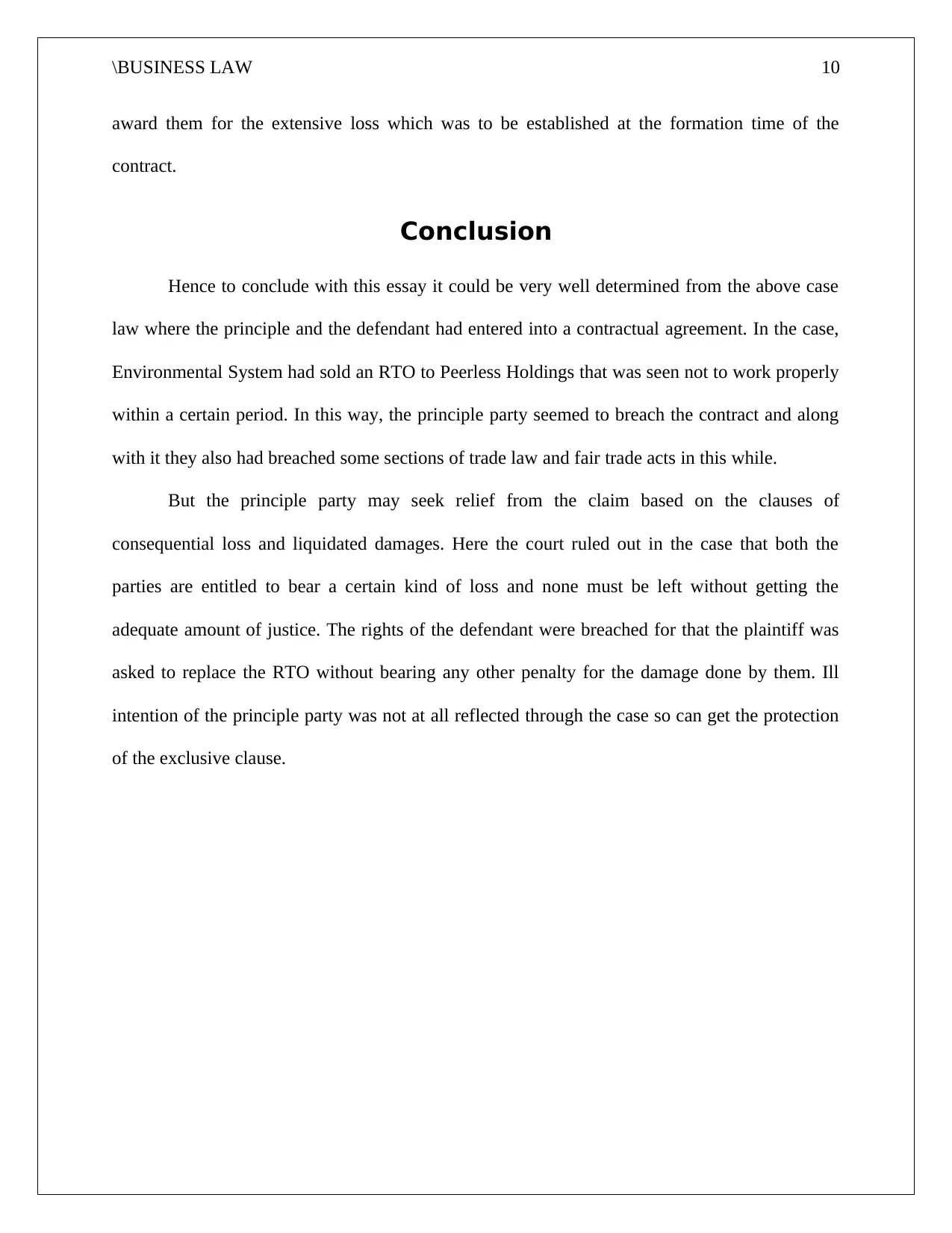
\BUSINESS LAW 10
award them for the extensive loss which was to be established at the formation time of the
contract.
Conclusion
Hence to conclude with this essay it could be very well determined from the above case
law where the principle and the defendant had entered into a contractual agreement. In the case,
Environmental System had sold an RTO to Peerless Holdings that was seen not to work properly
within a certain period. In this way, the principle party seemed to breach the contract and along
with it they also had breached some sections of trade law and fair trade acts in this while.
But the principle party may seek relief from the claim based on the clauses of
consequential loss and liquidated damages. Here the court ruled out in the case that both the
parties are entitled to bear a certain kind of loss and none must be left without getting the
adequate amount of justice. The rights of the defendant were breached for that the plaintiff was
asked to replace the RTO without bearing any other penalty for the damage done by them. Ill
intention of the principle party was not at all reflected through the case so can get the protection
of the exclusive clause.
award them for the extensive loss which was to be established at the formation time of the
contract.
Conclusion
Hence to conclude with this essay it could be very well determined from the above case
law where the principle and the defendant had entered into a contractual agreement. In the case,
Environmental System had sold an RTO to Peerless Holdings that was seen not to work properly
within a certain period. In this way, the principle party seemed to breach the contract and along
with it they also had breached some sections of trade law and fair trade acts in this while.
But the principle party may seek relief from the claim based on the clauses of
consequential loss and liquidated damages. Here the court ruled out in the case that both the
parties are entitled to bear a certain kind of loss and none must be left without getting the
adequate amount of justice. The rights of the defendant were breached for that the plaintiff was
asked to replace the RTO without bearing any other penalty for the damage done by them. Ill
intention of the principle party was not at all reflected through the case so can get the protection
of the exclusive clause.
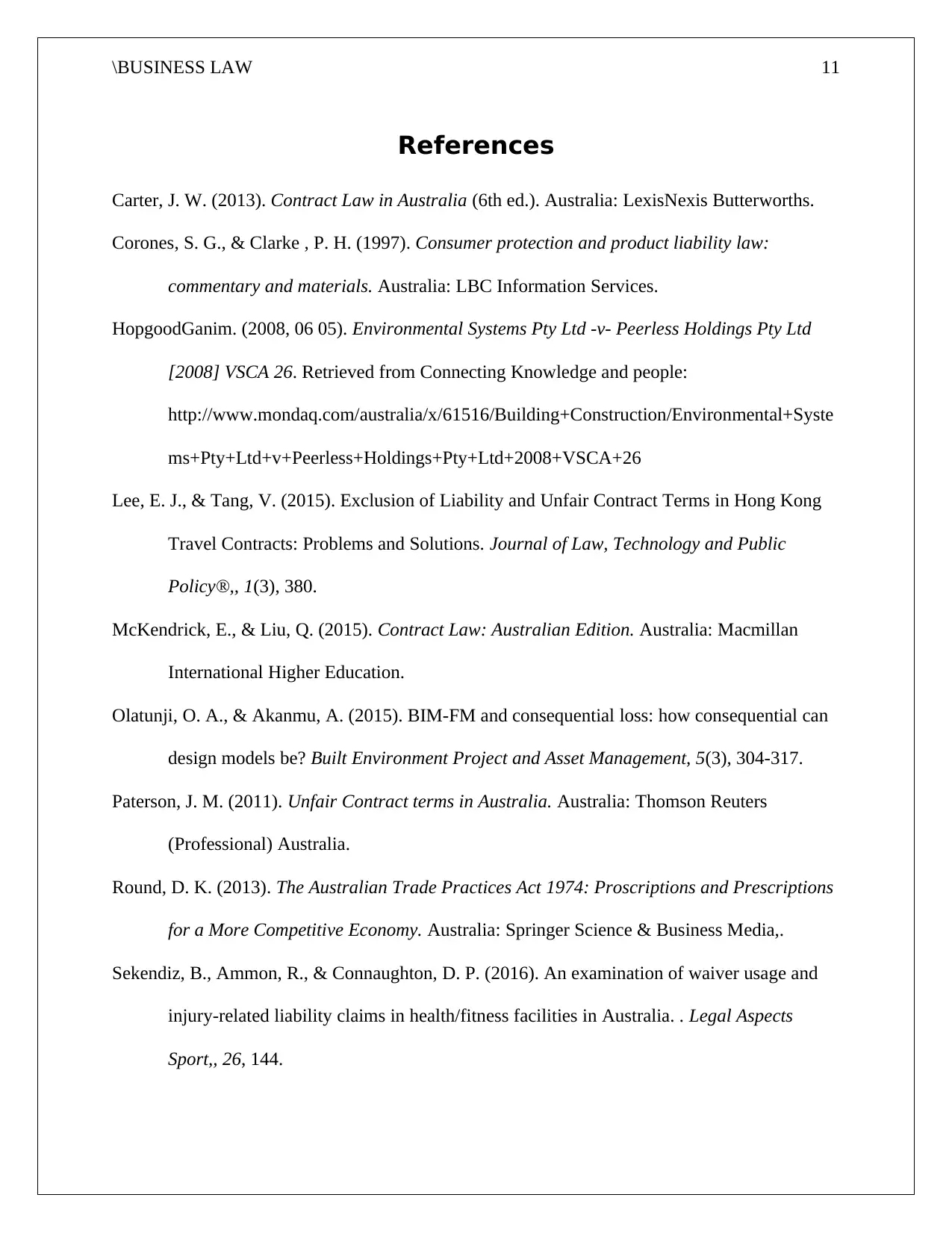
\BUSINESS LAW 11
References
Carter, J. W. (2013). Contract Law in Australia (6th ed.). Australia: LexisNexis Butterworths.
Corones, S. G., & Clarke , P. H. (1997). Consumer protection and product liability law:
commentary and materials. Australia: LBC Information Services.
HopgoodGanim. (2008, 06 05). Environmental Systems Pty Ltd -v- Peerless Holdings Pty Ltd
[2008] VSCA 26. Retrieved from Connecting Knowledge and people:
http://www.mondaq.com/australia/x/61516/Building+Construction/Environmental+Syste
ms+Pty+Ltd+v+Peerless+Holdings+Pty+Ltd+2008+VSCA+26
Lee, E. J., & Tang, V. (2015). Exclusion of Liability and Unfair Contract Terms in Hong Kong
Travel Contracts: Problems and Solutions. Journal of Law, Technology and Public
Policy®,, 1(3), 380.
McKendrick, E., & Liu, Q. (2015). Contract Law: Australian Edition. Australia: Macmillan
International Higher Education.
Olatunji, O. A., & Akanmu, A. (2015). BIM-FM and consequential loss: how consequential can
design models be? Built Environment Project and Asset Management, 5(3), 304-317.
Paterson, J. M. (2011). Unfair Contract terms in Australia. Australia: Thomson Reuters
(Professional) Australia.
Round, D. K. (2013). The Australian Trade Practices Act 1974: Proscriptions and Prescriptions
for a More Competitive Economy. Australia: Springer Science & Business Media,.
Sekendiz, B., Ammon, R., & Connaughton, D. P. (2016). An examination of waiver usage and
injury-related liability claims in health/fitness facilities in Australia. . Legal Aspects
Sport,, 26, 144.
References
Carter, J. W. (2013). Contract Law in Australia (6th ed.). Australia: LexisNexis Butterworths.
Corones, S. G., & Clarke , P. H. (1997). Consumer protection and product liability law:
commentary and materials. Australia: LBC Information Services.
HopgoodGanim. (2008, 06 05). Environmental Systems Pty Ltd -v- Peerless Holdings Pty Ltd
[2008] VSCA 26. Retrieved from Connecting Knowledge and people:
http://www.mondaq.com/australia/x/61516/Building+Construction/Environmental+Syste
ms+Pty+Ltd+v+Peerless+Holdings+Pty+Ltd+2008+VSCA+26
Lee, E. J., & Tang, V. (2015). Exclusion of Liability and Unfair Contract Terms in Hong Kong
Travel Contracts: Problems and Solutions. Journal of Law, Technology and Public
Policy®,, 1(3), 380.
McKendrick, E., & Liu, Q. (2015). Contract Law: Australian Edition. Australia: Macmillan
International Higher Education.
Olatunji, O. A., & Akanmu, A. (2015). BIM-FM and consequential loss: how consequential can
design models be? Built Environment Project and Asset Management, 5(3), 304-317.
Paterson, J. M. (2011). Unfair Contract terms in Australia. Australia: Thomson Reuters
(Professional) Australia.
Round, D. K. (2013). The Australian Trade Practices Act 1974: Proscriptions and Prescriptions
for a More Competitive Economy. Australia: Springer Science & Business Media,.
Sekendiz, B., Ammon, R., & Connaughton, D. P. (2016). An examination of waiver usage and
injury-related liability claims in health/fitness facilities in Australia. . Legal Aspects
Sport,, 26, 144.
⊘ This is a preview!⊘
Do you want full access?
Subscribe today to unlock all pages.

Trusted by 1+ million students worldwide
1 out of 13
Related Documents
Your All-in-One AI-Powered Toolkit for Academic Success.
+13062052269
info@desklib.com
Available 24*7 on WhatsApp / Email
![[object Object]](/_next/static/media/star-bottom.7253800d.svg)
Unlock your academic potential
Copyright © 2020–2025 A2Z Services. All Rights Reserved. Developed and managed by ZUCOL.





